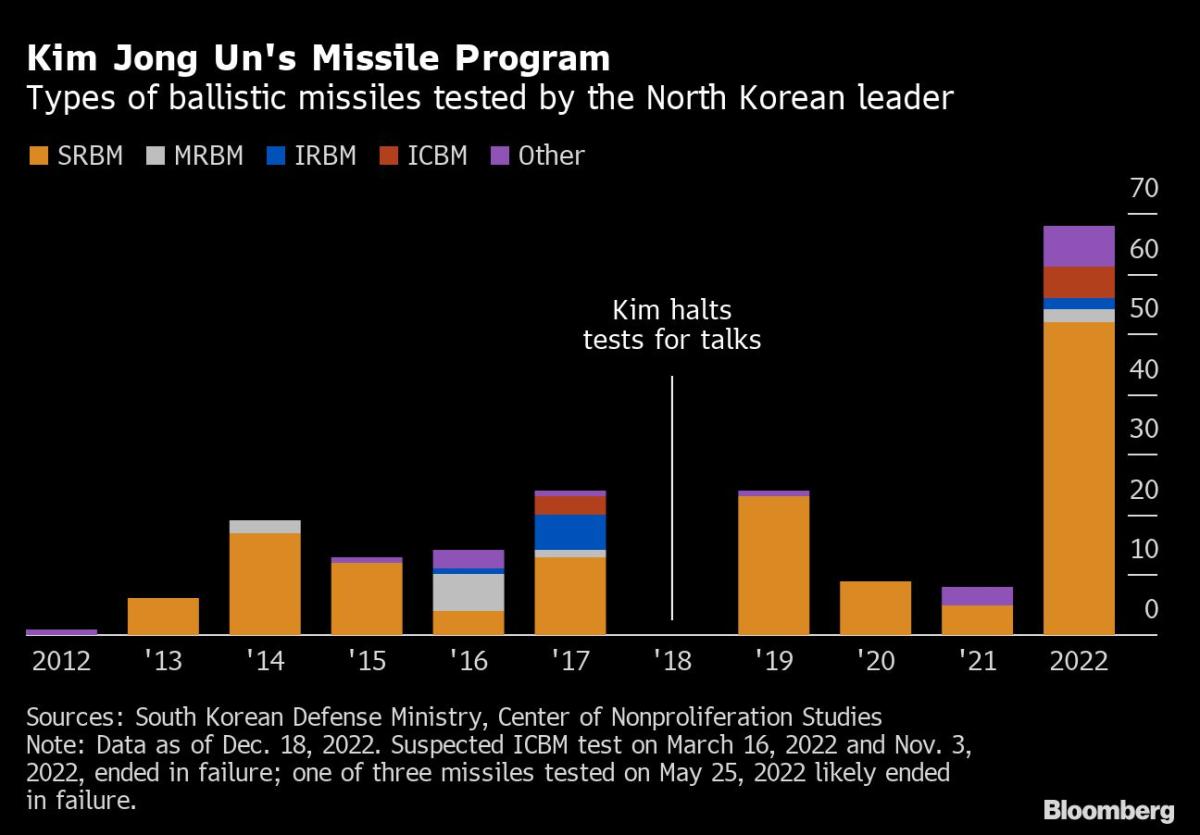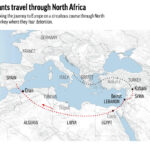
(Bloomberg) — North Korea fired at least two suspected medium-range ballistic missiles Sunday from near a site that a few days ago it tested a new solid-fuel rocket engine that could enhance its ability to launch quick-strike, longer-range missiles for delivering nuclear warheads.
Most Read from Bloomberg
Two medium-range ballistic missiles were launched between 11:13 a.m. and 12:05 p.m. from the Tongchang county area, South Korea’s Joint Chiefs of Staff said. Japan’s Defense Ministry said the projectiles traveled a distance of about 500 kilometers (310 miles), reached an altitude of about 550 km and landed outside of the country’s exclusive economic zone.
It was uncertain whether North Korea used the new engine in the missiles it fired. The flight paths of a medium-range missile could hit almost all of Japan.
Solid-fuel missiles are quick to deploy and can be easier to hide, giving the US and its allies less time to see signs of a launch and prepare interceptors. North Korean leader Kim Jong Un has been modernizing his arsenal over the past several years, and has rolled out new, nuclear-capable, short-range ballistic missiles that can strike US military bases in all of South Korea and parts of Japan.
The new solid-fuel engine could be used for the country’s Pukguksong series of submarine-launched ballistic missiles — a two-stage, nuclear-capable rocket that has a range to hit all of Japan. It could also be used for longer-range projectiles, including possible intercontinental ballistic ones that could deliver a nuclear warhead to the US mainland.
The US Indo-Pacific Command said in a statement that it was aware of the ballistic missile launch, which, while it does not pose an immediate threat to the US, “highlights the destabilizing impact” of North Korea’s weapons program.
South Korea’s presidential office convened a National Security Council meeting to discuss the launches, calling them an outright violation of UN Security Council resolutions and warning Pyongyang it will “rightly pay the price,” Yonhap reported.
This year, Kim Jong Un’s regime has already fired off more than 65 ballistic missiles, the most in his decade in power and in defiance of United Nations resolutions that prohibit the launches. He has stepped up provocations in recent months in a display of anger at joint military drills in the region by the US and its allies, South Korea and Japan.
Kim was on hand to oversee the test of the solid-fuel rocket engine, state media said Friday. “This important test has provided a sure sci-tech guarantee for the development of another new-type strategic weapon system,” the official Korean Central News Agency reported.
The missile tests underscore the challenges the Biden administration faces in trying to slow down Kim’s nuclear ambitions. The North Korean leader is finding space to ramp up provocations and conduct tit-for-tat military moves against the US and its allies as Biden focuses on Russia’s war in Ukraine.
North Korea on Nov. 18 test-fired an intercontinental ballistic missile designed to carry a nuclear warhead to the US mainland. Kim’s daughter made her first official appearance in state media at the launch, signaling there’s another generation to take over the Cold War’s last continuous family dynasty and it will depend on nuclear weapons for its survival.
The North Korean leader has been modernizing his arsenal by adding missiles that are quicker to deploy, maneuverable in flight and more difficult for US-operated interceptors in the region to shoot down.
The US, Japan and South Korea have warned that Pyongyang could soon raise tensions even higher with a nuclear test, which would be its first in five years and seventh overall. Washington, Tokyo and Seoul have all promised a harsh and coordinated punishment it Pyongyang goes ahead with a nuclear test, which would also be a violation of UN Security Council resolutions.
The nuclear test might be used to advance Kim’s pursuit of miniaturized nuclear warheads to mount on missiles to strike South Korea and Japan, which host the bulk of America’s troops in Asia.
The US push to isolate Russia over Vladimir Putin’s war in Ukraine, coupled with increasing animosity toward China, has allowed Kim to strengthen his nuclear deterrent without fear of facing more sanctions at the Security Council. There’s almost no chance Russia or China, which have veto power at the council, would support any measures against North Korea, as they did in 2017 following a series of weapons tests that prompted former President Donald Trump to warn of “fire and fury.”
The two countries in late May vetoed a UN Security Council resolution drafted by the US to ratchet up sanctions on North Korea for its ballistic missile tests this year.
–With assistance from Hiromi Horie and Kanoko Matsuyama.
(Updates with details of missile from first paragraph, official response from sixth.)
Most Read from Bloomberg Businessweek
©2022 Bloomberg L.P.




